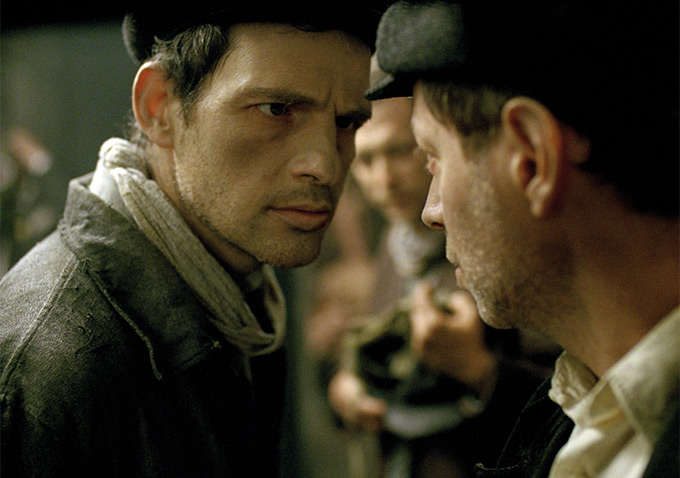 Depicting the Holocaust on screen has always been a prickly matter. For many years, it was shied away from entirely, with some arguing, perhaps correctly, that cinema was incapable of capturing the true horror of the most evil, repulsive acts that human beings have inflicted on each other.
Depicting the Holocaust on screen has always been a prickly matter. For many years, it was shied away from entirely, with some arguing, perhaps correctly, that cinema was incapable of capturing the true horror of the most evil, repulsive acts that human beings have inflicted on each other.
Over time, filmmakers became more confident in attempting it: sometimes sensitively and successfully ("The Pawnbroker," "Schindler’s List," obviously "Shoah"), sometimes in ways that felt crass and exploitative ("Life Is Beautiful"). At this point, not one but two installments of a superhero franchise have featured scenes set in concentration camps. "Son Of Saul," the first feature from Hungarian director László Nemes, and the rare first feature to premiere In Competition at Cannes, is a much more serious attempt at portraying the Holocaust, and though it has a few elements of its construction that might be questionable, it’s mostly a powerful, thoughtful, and visually striking picture.
The film centers, quite literally, on the titular Saul (Géza Röhrig), a Hungarian prisoner in an unnamed concentration camp. Saul is a Sonderkommando, who aids the Nazi guards in herding other Jewish captives into the gas chambers, burning their bodies and similar duties under threat of death.
READ MORE: Criterion Brings ‘Shoah,’ ‘Things To Come,’ ‘Safety Last,’ And More In June
One day, Saul sees a young boy pulled out of the chamber, only to be killed by a German. He thinks — no, is sure — that the boy is his own son, and sets out to obtain the body before it’s incinerated, find a Rabbi, and give the child a proper burial. But some of his fellow Sonderkommandos have been secretly gathering weapons and planning an uprising, and plan to strike at dawn, and Saul’s loyalties become sharply divided.

The best way to describe the look of "Son Of Saul" is probably "immediate." The almost-real-time action is played out in Academy ratio, and, with a color palette that belies that Nemes trained at Bela Tarr‘s film school, it’s shot (in 35mm) in long hand-held takes with its title character almost always at the focus of a very shallow-focus frame. It’s a very different kind of aesthetic, if aesthetic isn’t the wrong word, for a film like this, drawing from the same inspiration that Emmanuel Lubezki did in the combat sequences in "Children Of Men."
It’s a very ambitious move for a first-time filmmaker, but it pays off. The film has a visceral, experiential quality that captures both the mundane horror of Saul’s day-to-day duties in the early part of the film, and the Goya-esque hell as chaos erupts later on. The movement and blocking are minutely and meticulously choreographed, and the shallow focus and astonishing sound design mean that we only see glimpses or hear hints of the very worst terrors. It’s a bold attempt to find a new visual language for a film like this, and is very effective for it, depriving the audience of any distance, or reprieve, or any sense of payback once the uprising begins.
The film also functions as a thriller to some degree, as Saul (and it should be said here that Röhrig is remarkable throughout) searches the camp for both a rabbi and the tools that his comrades need to spark off their revolt. It puts morality at the center of the film: Should the Sonderkommandos be damned as collaborators? Is Saul’s quest to bury his son a selfish act? Does any of it matter in the context of the monstrous acts around them? These are all tough questions, and to his credit, Nemes has no interest in finding easy answers for them.
What isn’t clear is how deliberate the questions raised by the film’s form are. For all of its visceral quality, the over-the-shoulder perspective, and concentration-camp-tour construction of the screenplay, it’s queasily reminiscent of a "Call Of Duty"-style video game. Is the use of showy long takes and thriller-like plotting less exploitative than using more traditional dramatic devices to confront the horrors of the Holocaust, or more? At a time when concentration camps feature in "X-Men" movies, does it even matter?
36 hours on, I’m not sure I have the answers to these questions, and it’s something that’s sure to be debated as more audiences get the chance to see "Son of Saul." Regardless of where they end up, however, they’ll be confronted with an enormously technically accomplished debut from a confident new voice, one that carries impressive moral heft and enormous power, even if you may be left feeling a little uneasy because of its form, as well as its content. [B+]
Check out the rest of our coverage from the 2015 Cannes Film Festival by clicking here.







Maybe its better to dont read all critics and just zapping TV suddently this movie will catch me…sryfor english. But i hate ignorance and also from them which mean you have to face this movie because Holocaust etc…tell me how many movies was made about sinti and romas which also where genozid? Not a one…20 mio russian died in WW2 only. From qnt (horrible to write ) the biggest bill! If Stalin was only the bad guy for this even that he let his son die in german horror prison? No movie or media about it. Then to be maybe sarcastic did WW2 from view surviving of the fittest made hebrew stronger? So now maybe you see the relations. And who was the biggest genozider? Mao. Indirectly or not but with ignorance he tops 20 mio russians at more then 100….killing by ruling so most died hungry. And now the point? Is one chinese life equal to a jews? Hollywood says NEVER. Now you maybe see like me….hopefully not 😉
I hope this means that next year there will be more than one first time filmmaker in competition.